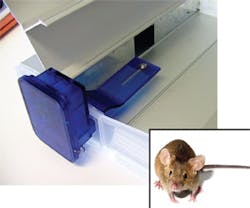Self-Powered, Wireless Technology Opens New Applications
Thanks to thermoelectric devices, higher-performance solar panels, and bidirectional signal capability, energy-harvesting sensors and controllers are offering more solutions for sustainable buildings.
Originating in Germany, the wireless technology promoted by the EnOcean Alliance (www.enocean-alliance.org) and its partners offers controls without batteries. The energy-harvesting devices are enabled by radio protocols that permit signals – also known as "telegrams" in EnOcean parlance – to be transmitted in extremely brief, energy-conserving bursts. In addition, the devices have sleep modes with ever more minuscule power demands.
Two types of wireless devices that have been in use for several years are mechanical switches, in which the movement of the switch generates the wireless signal, and devices with photovoltaic panels, which store the energy necessary for transmitting.
A third type of wireless switch entering the market uses the thermoelectric effect to create voltage through a temperature differential on each side of the device. Thermoelectric devices can be used for wireless control of heat radiators by harvesting energy from the temperature differential between the water pipe and ambient air. These devices can have sufficient voltage not only to communicate but also to actuate a radiator valve. Similar devices for use in ductwork will be launched as early as the end of the year, according to Jim O’Callaghan, president, EnOcean North America.
Send and Receive Operation
Recent wireless devices incorporating EnOcean’s Dolphin platform can transmit and receive signals. Larger solar cells have increased the voltage storage capacity; power management and more sophisticated radio protocols also support the receiving function. A device can transmit a signal, go into sleep mode, and then power up at a preprogrammed instant in order to receive a return signal from a controller. Using this technology, temperature sensors and other devices that must transmit signals continually, even in darkened spaces, have sufficient solar and power management capabilities to accomplish the task.
Wireless, batteryless technology can be a good fit for hotels and hotel retrofits. The Kahana Falls Hotel in Hawaii – where basic electricity prices are nearly three times higher than the national average – was retrofitted with wireless key card switches, occupancy detectors, and door sensors. Key cards function as master switches for guestrooms. When a guest removes a key card from its dock, air conditioning and lighting are switched off. Air conditioning is also turned off if a solar-powered sensor detects that a balcony door or window has been open for a programmed period of time.
According to EnOcean, the energy savings from the hotel’s wireless retrofit is 20 percent, and the payback is 16 months; factoring in state financial incentives that the hotel’s owner received, the payback was only 8 months. Eliminating the installation of new wiring reduced initial costs and disruption to hotel operations.
Application Sweet Spots for the Technology
Other application sweet spots for the wireless technology include schools and office buildings without DDX controls, according to O’Callaghan. EnOcean technology offers a degree of automation via new sensors and controls without installing wires or going inside walls and ceilings. In the case of schools, the daylight available in classrooms suits them to solar-powered devices, and the irregular schedule enhances the opportunity to save energy when spaces are unoccupied. The wireless technology can also be a fit for smaller buildings that may not have access to facilities professionals experienced in operating more sophisticated, PC-based automation systems.
EnOcean devices and BACnet backbones may soon have interoperable solutions through a common gateway. The EnOcean Alliance and BACnet International announced in January that they are working together to produce standard specifications for connecting wireless extensions to wired BACnet infrastructures. Some suppliers are already offering such integrated solutions.
Chris Olson ([email protected]) is editor in chief of Buildings magazine.
